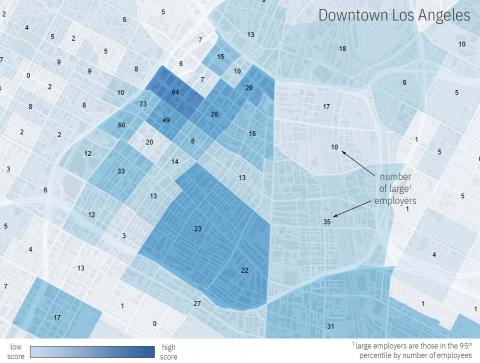
With a grant awarded by the MSRC, researchers at the UCLA Luskin Center for Innovation (LCI) have identified workplace locations in the South Coast Air Quality Management District (AQMD) high demand for electric vehicle charging, and consequently high potential to increase zero-emission miles traveled and reduce local air pollution. LCI conducted this study in order to support local governments and utilities in making data-driven decisions on where to invest in charging equipment and electrical capacity.
In their analysis, LCI researchers focused specifically on the additional electric miles traveled by Plug-in Hybrid Electric Vehicles (PHEVs), which have short battery-only ranges and burn gasoline once their state of charge can no longer support all-electric operation. Battery Electric Vehicles (BEVs), on the other hand, only drive on electric power and have ranges that exceed typical two-way work commute distances.
Preliminary findings from LCI’s study reveal that more than 88,000 PHEVs are used for commutes to workplaces in the South Coast AQMD region, and that nearly 50% of these PHEVs are likely being used for commutes that exceed the vehicles’ all electric-range. Such vehicles are underutilized resources, which when given the opportunity to charge at work, could yield as many as 480,000 additional electrically driven commute miles per day without requiring any new vehicle purchases.

To arrive at these estimates, LCI researchers developed a spatial model that combines historical data on PHEV registrations with modeled work commutes in the South Coast AQMD region. LCI researchers determined the overnight residence and electric ranges of PHEVs using dealership sales data. The Southern California Association of Government (SCAG) provided LCI researchers with commute travel patterns estimated using their regional travel demand model. LCI researchers combined these two inputs to simulate PHEV commutes within the South Coast AQMD region and estimate the density and round trip lengths of PHEV commutes. The difference between the round trip length and the electric ranges of commuting PHEVs then yields an estimate of the additional electric miles that can be supported by investments in workplace charging.
LCI’s study was conducted at the scale of transportation analysis zones (TAZs), which are geographic units built from census blocks. TAZs encompass areas of equal population or employment for use in travel demand forecast modeling. This scale will help planners at municipal and utility agencies prioritize investments where additional charging equipment and electrical capacity is most needed in the South Coast AQMD region. A higher number of potential electric miles within a TAZ signals that a workplace within that TAZ is a good choice for securing public benefits from workplace charging investments.
LCI’s final report will be released in early 2020. The results from the study also will be incorporated into SCAG’s online mapping tool, known as the PEV Atlas, which allows users to locate their geography of interest and overlay a variety of data layers that help inform where charging stations are particularly needed. LCI’s contributions to the PEV Atlas will allow users to visualize the overlap between: (1) the relative number of electric miles that can be gained by investments in workplace charging and (2) the locations of large employers (see figure below). Targeting large employers will further enhance the likelihood that investments in electric vehicle charging equipment are used on a regular basis.
The PEV Atlas in its current form can be accessed at the following link:
LCI’s portfolio of electric vehicle planning work can be accessed here:
